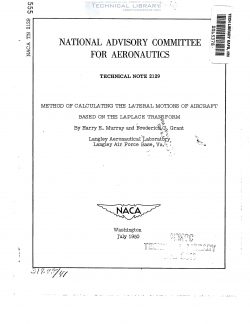naca-tn-2129
- Version
- 128 Downloads
- 1.64 MB File Size
- 1 File Count
- December 9, 2016 Create Date
- December 9, 2016 Last Updated
National Advisory Committee for Aeronautics, Technical Notes - Method of Calculating the Lateral Motions of Aircraft Based on the Laplace Transform

The lateral motions of aircraft are obtained by means of the
Laplace transform which gives solutions expressed in terms of elementary
functions for the free and forced motions. These equations permit the
calculation of the free motion of an aircraft following any initial
condition or the forced motion following the application of constant
external forces and moments. These forced motions can be used to obtain
by means of Duhamel's integral the response to any arbitrary forcing
function. All the classical stability concepts can be deduced from
these same solution equations largely by inspection. These equations
for the lateral motion are applied to the calculation of the lateral
stability of a specific airplane and to the calculation of certain of
its free and forced motions.
The lateral motions of aircraft are represented by three simultaneous
differential equations which are generally assumed to be linear. The
fundamental problem of lateral dynamics involves the solution of these
differential equations in terms of the aerodynamic and mass parameters
of the airplane. The solutions can then be used to Obtain numerically
the motion of the airplane as a function of time.
The recent application of the Laplace transform to the solution of
systems of linear differential equations permits a more general analysis
of the problem of airplane motion than that of reference 1, which is
based upon Heaviside's operational calculus. Heaviside's operational
calculus permits a calculation of the forced motion, which is the motion
following the application of external forces and moments. The Laplace
transform permits these same calculations and also permits the direct
calculation of the free motion, which is the motion following finite
initial values of the variables and their first derivatives in the
absence of externally applied forces and moments. This calculation
cannot be made by use of Heaviside‘s operational calculus. The Laplace
transform solutions, which include both the free and forced motions, may
be written in a closed form from which all the classical stability con-
cepts can be deduced largely by inspection. The form of the equations
of motions of the airplane is independent of such aerodynamic parameters
as Reynolds number and Mach number, and these parameters enter the equa-
tions only as they effect the values of the aerodynamic constants or
stability derivatives appearing in the equations. The values of the
stability derivatives must‘be obtained by actual measurements during
physical tests or from aerodynamic theory before motion calculations can
be attempted.
| File | Action |
|---|---|
| naca-tn-2129 Method of Calculating the Lateral Motions of Aircraft Based on the Laplace Transform.pdf | Download |

Comment On This Post